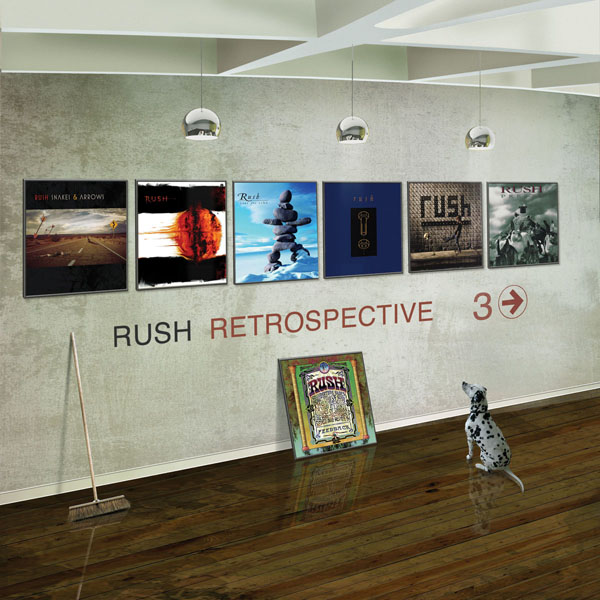After The Gold Rush
Rob Fitzpatrick got off the Rush bus at the end of their 1970s gilded era of progular grandiosity. So what happens to a band who keep going when there's no particular reason to stop?
By Rob Fitzpatrick, Word, April 2009, transcribed by pwrwindows

RUSH Retrospective Ill (1989-2008) ATLANTIC
As I might possibly have mentioned before, my early teenage years were largely devoted to Rush. I haven't got the same sort of desire for concept albums about dystopian future worlds where the discovery of a guitar upsets the unnatural order of things that I used to have, but I reserve a special place in my heart for long-haired Canadians playing double-neck guitars while sporting expensively embroidered silk kimonos. There will always be a part of me that thinks, "That is what a rock and roll group should look like." Confident. Ridiculous. So ridiculously confident they could walk into a bar dressed like hormonally challenged cast members of Madame Butterfly and just sort of get away with it. If you don't believe in yourself enough to go all the way, then really, why bother? Of course, then there's the musicianship, a concept so utterly unfashionable you're barely allowed to think it, but, Jesus, those bastards could really play. I wanted to be in a pop group because of Rush, I wanted to buy records and go to gigs and buy magazines and grow my hair because of Rush. I thought - still think - that's there's nothing wrong with writing songs called "By-Tor And The Snow Dog" or "The Fountain Of Lamneth", because pop music is meant to be fun, right? It's meant to make your heart lighter and your head freer; we're not meant to take it seriously, are we? Having said that, the last (the only) Rush album I went to the shop and bought on the day it came out was the synth-led Grace Under Pressure by which time kimonos and doublenecks were out and synths and lyrics about acid rain were in.
That was 25 years ago and this compilation doesn't begin until four years after that, not in the middle of some "wilderness years" - Rush are still a huge act - but the years that came some time after the amazing years. Although it's admirable to have a catalogue so vast that the best-ofs can run to three volumes, that doesn't mean that Volume III is actually any good. This is not to say it's a cash-in - there's nothing here for the casual listener; this volume is for the hardcore, the lifers. But the Rush I fell for is a different beast to the one on display here.
The longest track only just scrapes over six minutes - 1975's "By-Tor" had barely got through its 'At The Tobes Of Hades' section in that time - and this is not the place to start your relationship with the band. While their '70s and early '80s albums are often fanciful, filigreed affairs, the simple teen thrills celebrated in something like 1975's "Lakeside Park" or the glacially spare funk rock of 1981's "Red Barchetta" sound far less dated than the stadium-lite traumatics of 2004's Bravado or, from the same year, the pass-me-the-sequencer sledgehammer-isms of "Roll The Bones". 2006's "Driven" makes as many plays on its title as possible ("Driven in, driven out, driven to the edge, it's my turn to drive"), the guitars churn and thunder and it picks up the pace for a Police-like, double-time chorus, but it's never exactly loveable and neither is 1993's "Leave That Thing A Lone", a song oddly reminiscent of Captain Sensible's "Wot", despite it being almost inconceivable that the band would ever even have heard it.
A track like "Dreamline" outlines a few of the inherent problems of the later Rush - namely lyrics like, "They travel in the time of the prophets/On a desert highway straight to the heart of the sun", which were perfectly acceptable as late as 1978, but by 1991, as the world was taking in Nevermind and Blue Lines, sounded ridiculous, and not in a good way. 1993's "Nobody's Hero" tackles the Aids-related death of a friend of the band and the murder of a girl from the drummer's hometown, but it suffers from a cloying Big Music sheen that drowns the sentiment in reverb and overbearing strings.
But what could the band do? They had cut their hair and embraced technology a full decade earlier, the painful bit was already done; now what they had to try and work out, what all bands have to work out, is what they're for, what the point of their continued existence is. For Rush, it seems, the journey is the point. They are now, 35 years after they formed, bigger than they've ever been, playing to enormous audiences - of often very young fans - all over the world. There isn't a single track among the 14 songs collected here that I particularly like (though I'm partial to 1989's "The Pass"), there is nothing that I wouldn't happily swap for "Different Strings" or "Tom Sawyer" or even "Cygnus X-1", but the fact they're still doing it, still enjoying the fight, makes me very happy indeed.